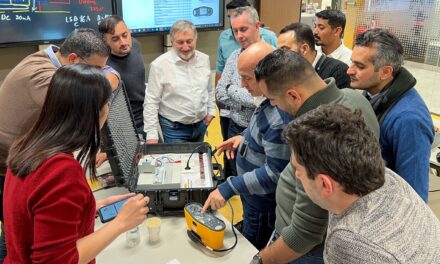 Rod Taylor, managing director of the Seaward Group, looks at the latest developments in digital microhmmeter earth bonding measurement and related safety testing and how it can help protect wind turbines from lightning strikes
Rod Taylor, managing director of the Seaward Group, looks at the latest developments in digital microhmmeter earth bonding measurement and related safety testing and how it can help protect wind turbines from lightning strikes
As the government in the UK has continued to press ahead with the green agenda, so the number of wind farms coming online has increased. Indeed, not only have the number of wind farms increased – so too has their height (upwards of 60m). However, this has made them more vulnerable to lightning strikes, which has resulted in an incidence of damage greater than anticipated, with repair costs escalating to the point where it’s almost economically unsustainable.
Therefore, it has become vitally important for those responsible for turbine design, build and maintenance programmes to incorporate control wiring systems capable of withstanding the most severe of lightning strikes – one which could potentially contain one billion volts and between 10,000 to 200,000 amperes of current (the average flash can power a 100W light bulb for three months).
Two tasks for protection
Essentially, any protection approach for wind turbines must fulfil two tasks – the provision of a low impedance path for lightning current to flow to the ground and the protection of electronics and electrical equipment from damage induced voltage effects and transferred potentials.
The hazard to equipment tends to arise from two sources. The large magnetic fields produced by a lightning strike may result in large magnitudes of induced voltages in wiring. A rise in earth potential also results in the possibility of high potentials present at one wind turbine causing damage to the electronics/electrical systems within the turbine itself and at remote turbines.
Induced voltage effects can be avoided by sensible routing of wiring, the use of bonding wires and the provision of cable trays that are bonded to the wind turbine at both ends. The use of cable trays in particular may result in induced voltage levels being reduced by a factor of ten.
Although transient suppression devices can be used for protection of components from large transferred potentials, it is important to ensure that such devices are located close to good earthing points (these are generally readily available on a wind turbine).
Earthing matters
Wind farms are commonly situated in areas with high soil resistivities, so earthing systems are geographically distributed over a large area. A total of five kilometres of earth electrode or more is not uncommon on such a site. Unlike compact earthing systems conventionally used for lightning protection purposes, the earthing system of a wind farm has a high inductive reactance which needs to be included when assessing the performance of the earthing system during a lightning strike.
Another important factor relating to earthing and human safety is the provision of equipotential bonding within a wind turbine to ensure that no hazardous touch voltages will occur during a lightning strike.
The lightning protection system of a wind turbine must be designed to carry lightning current to earth and protect the turbine from damage. While the overall protection of key assets like blades is important, protection of other smaller, cheaper components is nevertheless important – electronic control systems for example must be protected from damage through induced voltage and large transferred potentials. The failure of the control system is one of the biggest contributors to wind turbines being offline or not functioning properly.
As wind turbines get higher and higher so will the frequency of lightning strikes, so it’s not only important that the protection systems used are continually improved but also properly tested and maintained, including earth bonding measurement and related safety testing applications.
Microhmmeters
The latest generation of digital microhmmeters, like the Cropico DO7010 from Seaward, ensures accurate and reliable low resistance measurement and can be used with 90m long test leads without any adverse effect on the accuracy of measurement taken.
As a result, test and inspection engineers can test the safety bonding of wind turbines from top to bottom with one instrument. In addition, a test current capability of up to 10A allows for bonding checks to be made through any surface corrosion that can develop in outdoor locations.
Also, wind turbines often incorporate an embedded Faraday cage or shield built into the tower structure – an enclosure formed by conducting material or by a mesh of such material. These provide protection against a lightning strike for service crew undertaking maintenance and repairs or to prevent damage to mechanical, electrical and electronic equipment – the DO7010 can also be used to check the cage is functioning correctly and afford the requisite level of protection.
An LCD panel displays full information on measurement configuration and a single start button ensures ease of use while the ability to trigger measurements by lead contact to the test device enables fast single person operation. A remote hand terminal is also available to fully control the tester up to a distance of 15m.
Other features include true four terminal measurement to eliminate lead resistance errors, auto average of forward/reverse measurement and sequence testing with memory for 1,000 readings.






